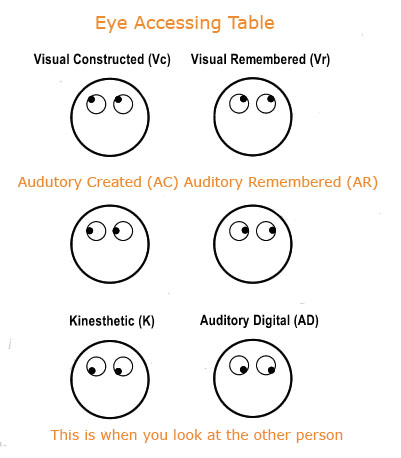Eye Accessing can be useful for sports performers or athletes when they need to access different types of information and memories during training or competition.
During a competition, an athlete may use Eye Accessing to access different types of memories or mental images to enhance their performance. For example, they may use visual recall to remember a successful performance in the past or use auditory recall to remember a coach's encouraging words. This can help the athlete to stay focused, motivated, and confident during the competition.
Their eyes may be in the wrong place to access the desired resource. By correcting where their eyes are placed. It is possible to enhance their performance

Case Study
I previously worked with a young basketball player who struggled with free-throw shooting. I noticed that the player consistently looked up and to their left before taking their free throws. I knew that looking up and to the left is associated with visual recall, which could be impacting their free throw performance.
Knowing that free throw shooting involves a lot of mental focus and visualization, I decided to try an Eye Accessing Technique with the player. I used the Focused Awareness Technique and then got him to imagine a successful free-throw, seeing the ball go through the hoop, hearing the sound of the net, and feeling the ball leave their fingertips. Then, I instructed them to notice which direction their eyes move when they imagine this successful free throw.
After some experimentation, I discovered that the player's eyes moved up and to their right when they imagined a successful free throw. I explained that this direction is associated with visual construction, or creating new visual images. I then worked with the player to incorporate this eye movement pattern into their free throw routine, asking them to consciously look up and to the right before taking their shot and visualizing a successful outcome.
Over time, with practice and repetition, the player's free throw percentage improved. They reported feeling more focused and confident during their shots, and attributed their success to the Eye Accessing technique I introduced them to.
Exercise
Begin by observing where your client's eyes are looking in relation to their goal.
If their eyes are in the wrong position, ask them to notice and score between 1 and 10 where they think they are in relation to their goal.
Guide them to move their eyes to the correct position.
Ask them to notice any differences they feel or experience with their eyes in the correct position and give a score out of 10.
Celebrate their progress and success.
Below is an explanation of where the eyes go when looking at another person.
Eyes move up and to the right
NLP term: Visual Remembered
NLP notation: Vr
The brain is accessing an image or some sort of visual memory of something the person has seen before.
Eyes move up and to the left.
NLP term: Visual Construct
NLP notation: Vc
The brain is creating a visual image, something it hasn’t seen before. Fantasy./imagnation
Eyes move directly to the right side
NLP term: Auditory Remembered
NLP notation: AR
The brain is accessing a sound or some sort of auditory memory of something the person has heard before.
Eyes move directly to the left side
NLP term: Auditory Created
NLP notation: AC
The brain is creating a sound. Fantasy/imagination.
Eyes move down and to the right
NLP term: Auditory Digital A person is talking to him or herself. The brain is processing an internal dialogue
NLP notation: Ad
Eyes move down and to the left
NLP term: Kinesthetic
NLP notation: K
A person is feeling something 1) This could be feeling something on the skin by for instance touching, or temperature (tactile), Or 2) emotion (visceral)
Eyes straight ahead de-focused or dilated -large pupils
NLP term: none
NLP notation: none
A person is using the brain to quickly access sensory information such as sound, feelings, or images. Usually something visual.
NOTE – This model is accurate in the main for most people. The remainder are reverse organized in one or more plains. Anyone can be reversed organized in any plain. This is why it is essential to calibrate the individual,

